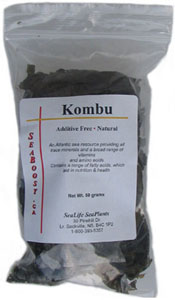 Kombu
Kombu
Kombu, also called dashima are edible kelp from genus Laminara widely eaten in Northeast Asia.
Cooking
Kombu is used extensively in Japanese cuisines as one of the three main ingredients needed to make dashi, a soup stock. Kombu is usually sold dried or in a dried shred called "Oboro kombu". It may also be eaten fresh as sashimi. Making kombu dashi is simple though kombu dashi powder may also be used. A strip of dried kombu is often boiled from the very first step of making a dish and is commonly eaten after cooking.
It is also important in Chinese cuisine and Korean cuisine.
Kombu may be pickled with sweet and sour flavoring and are cut into small strips 5 or 6 centimeters long and 2 centimeters wide. These are often eaten as a snack with green tea.
Kombu is a rich source of glutamic acid, an amino acid responsible for umami ("Wonderful Taste") one of the five basic tastes. Glutamic acid is used in the production of MSG.
It can be included when cooking beans to add nutrients and improve their digestibility.
The distinctive "umami" taste is common to mushrooms, cheese, tomatoes, asparagus and meats, is neither sweet, nor sour, nor bitter, nor salty, -- the Classic Four.
This fifth basic taste is derived from glutamate, an amino acid.
It differs from the other basic tastes in that it doesn't seem to impart a particular quality, but rather appears to interact with other taste stimuli to enhance a food's overall flavour.
References: Professor Kikunae Ikeda - Tokyo Imperial University -- Leslie J. Stein - Monell Chemical Senses Center
Order Kombu Flakes
| Kombu 454 grams - $57.30 | |
| Kombu Flakes 80 grams - $13.00 |
